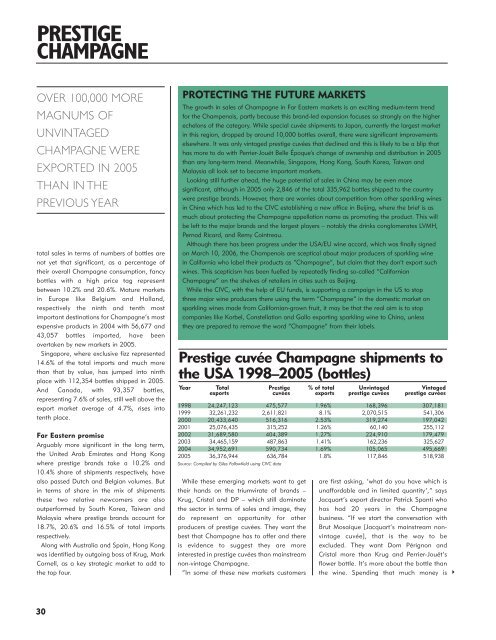Create successful ePaper yourself
Turn your PDF publications into a flip-book with our unique Google optimized e-Paper software.
PRESTIGE<br />
CHAMPAGNE<br />
OVER 100,000 MORE<br />
MAGNUMS OF<br />
UNVINTAGED<br />
CHAMPAGNE WERE<br />
EXPORTED IN 2005<br />
THAN IN THE<br />
PREVIOUS YEAR<br />
total sales in terms of numbers of bottles are<br />
not yet that significant, as a percentage of<br />
their overall <strong>Champagne</strong> consumption, fancy<br />
bottles with a high price tag represent<br />
between 10.2% and 20.6%. Mature markets<br />
in Europe like Belgium and Holland,<br />
respectively the ninth and tenth most<br />
important destinations for <strong>Champagne</strong>’s most<br />
expensive products in 2004 with 56,677 and<br />
43,057 bottles imported, have been<br />
overtaken by new markets in 2005.<br />
Singapore, where exclusive fizz represented<br />
14.6% of the total imports and much more<br />
than that by value, has jumped into ninth<br />
place with 112,354 bottles shipped in 2005.<br />
And Canada, with 93,357 bottles,<br />
representing 7.6% of sales, still well above the<br />
export market average of 4.7%, rises into<br />
tenth place.<br />
Far Eastern promise<br />
Arguably more significant in the long term,<br />
the United Arab Emirates and Hong Kong<br />
where <strong>prestige</strong> brands take a 10.2% and<br />
10.4% share of shipments respectively, have<br />
also passed Dutch and Belgian volumes. But<br />
in terms of share in the mix of shipments<br />
these two relative newcomers are also<br />
outperformed by South Korea, Taiwan and<br />
Malaysia where <strong>prestige</strong> brands account for<br />
18.7%, 20.6% and 16.5% of total imports<br />
respectively.<br />
Along with Australia and Spain, Hong Kong<br />
was identified by outgoing boss of Krug, Mark<br />
Cornell, as a key strategic market to add to<br />
the top four.<br />
30<br />
PROTECTING THE FUTURE MARKETS<br />
The growth in sales of <strong>Champagne</strong> in Far Eastern markets is an exciting medium-term trend<br />
for the Champenois, partly because this brand-led expansion focuses so strongly on the higher<br />
echelons of the category. While special cuvée shipments to Japan, currently the largest market<br />
in this region, dropped by around 10,000 bottles overall, there were significant improvements<br />
elsewhere. It was only vintaged <strong>prestige</strong> cuvées that declined and this is likely to be a blip that<br />
has more to do with Perrier-Jouët Belle Époque's change of ownership and distribution in 2005<br />
than any long-term trend. Meanwhile, Singapore, Hong Kong, South Korea, Taiwan and<br />
Malaysia all look set to become important markets.<br />
Looking still further ahead, the huge potential of sales in China may be even more<br />
significant, although in 2005 only 2,846 of the total 335,962 bottles shipped to the country<br />
were <strong>prestige</strong> brands. However, there are worries about competition from other sparkling wines<br />
in China which has led to the CIVC establishing a new office in Beijing, where the brief is as<br />
much about protecting the <strong>Champagne</strong> appellation name as promoting the product. This will<br />
be left to the major brands and the largest players – notably the drinks conglomerates LVMH,<br />
Pernod Ricard, and Remy Cointreau.<br />
Although there has been progress under the USA/EU wine accord, which was finally signed<br />
on March 10, 2006, the Champenois are sceptical about major producers of sparkling wine<br />
in California who label their products as “<strong>Champagne</strong>”, but claim that they don’t export such<br />
wines. This scepticism has been fuelled by repeatedly finding so-called “Californian<br />
<strong>Champagne</strong>” on the shelves of retailers in cities such as Beijing.<br />
While the CIVC, with the help of EU funds, is supporting a campaign in the US to stop<br />
three major wine producers there using the term “<strong>Champagne</strong>” in the domestic market on<br />
sparkling wines made from Californian-grown fruit, it may be that the real aim is to stop<br />
companies like Korbel, Constellation and Gallo exporting sparkling wine to China, unless<br />
they are prepared to remove the word “<strong>Champagne</strong>” from their labels.<br />
Prestige cuvée <strong>Champagne</strong> shipments to<br />
the USA 1998–2005 (bottles)<br />
Year Total Prestige % of total Unvintaged Vintaged<br />
exports cuvées exports <strong>prestige</strong> cuvées <strong>prestige</strong> cuvées<br />
1998 24,247,123 475,577 1.96% 168,396 307,181<br />
1999 32,261,232 2,611,821 8.1% 2,070,515 541,306<br />
2000 20,433,640 516,316 2.53% 319,274 197,042<br />
2001 25,076,435 315,252 1.26% 60,140 255,112<br />
2002 31,689,580 404,389 1.27% 224,910 179,479<br />
2003 34,465,159 487,863 1.41% 162,236 325,627<br />
2004 34,952,691 590,734 1.69% 105,065 495,669<br />
2005 36,376,944 636,784 1.8% 117,846 518,938<br />
Source: Compiled by Giles Fallowfield using CIVC data<br />
While these emerging markets want to get<br />
their hands on the triumvirate of brands –<br />
Krug, Cristal and DP – which still dominate<br />
the sector in terms of sales and image, they<br />
do represent an opportunity for other<br />
producers of <strong>prestige</strong> cuvées. They want the<br />
best that <strong>Champagne</strong> has to offer and there<br />
is evidence to suggest they are more<br />
interested in <strong>prestige</strong> cuvées than mainstream<br />
non-vintage <strong>Champagne</strong>.<br />
“In some of these new markets customers<br />
are first asking, ‘what do you have which is<br />
unaffordable and in limited quantity’,” says<br />
Jacquart’s export director Patrick Spanti who<br />
has had 20 years in the <strong>Champagne</strong><br />
business. “If we start the conversation with<br />
Brut Mosaique [Jacquart’s mainstream nonvintage<br />
cuvée], that is the way to be<br />
excluded. They want Dom Pérignon and<br />
Cristal more than Krug and Perrier-Jouët’s<br />
flower bottle. It’s more about the bottle than<br />
the wine. Spending that much money is<br />
�


